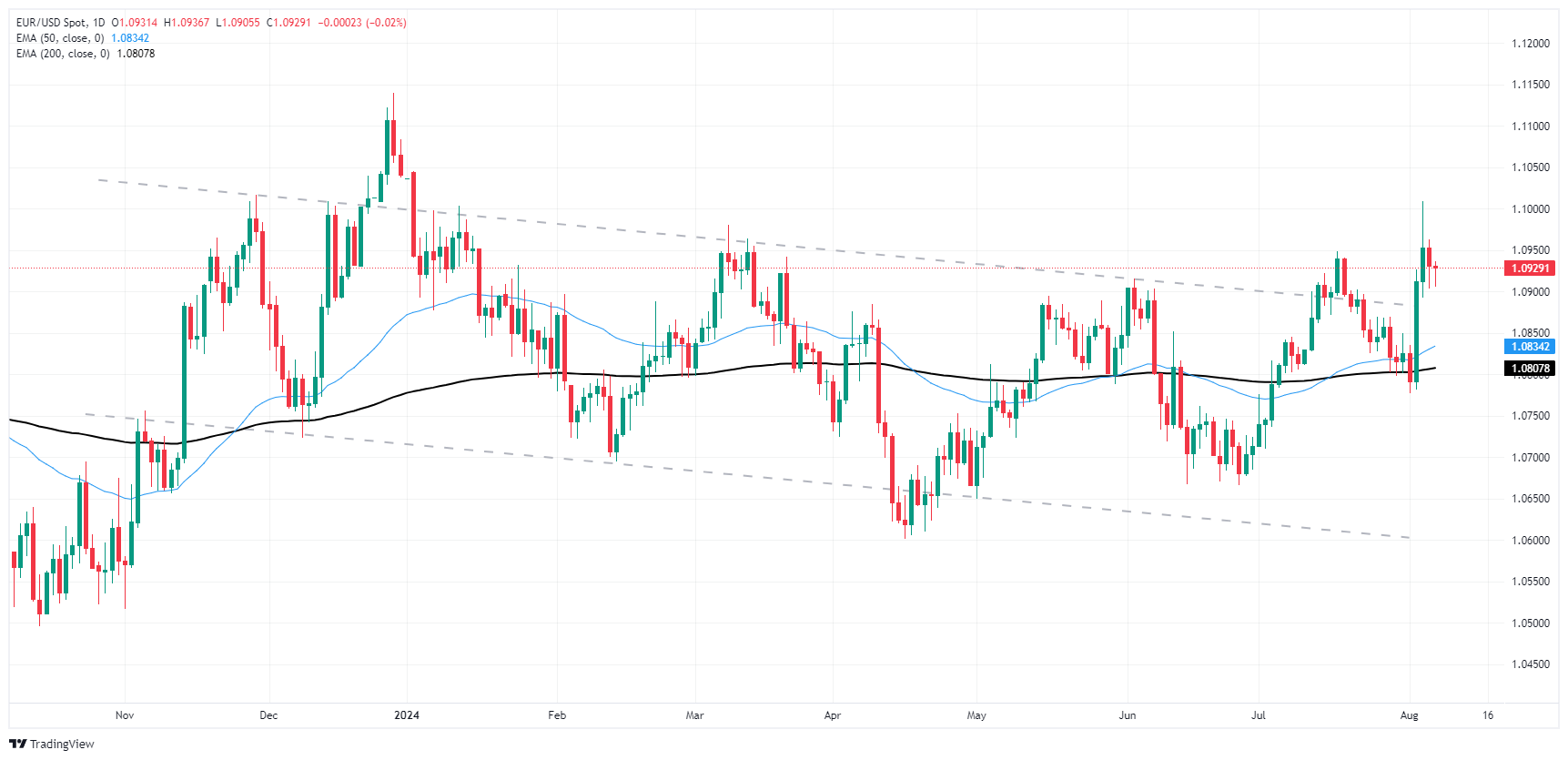- Аналітика
- Новини та інструменти
- Новини ринків
- EUR/USD pulls into the middle just above 1.0900
EUR/USD pulls into the middle just above 1.0900
- EUR/USD floundered on Wednesday as markets remain tepid.
- Investors taking a breather after a rough rebalancing late last week.
- Despite breaking higher in recent days, Fiber bids run out of steam.
EUR/USD paddled in a tight circle on Wednesday, churning just above the 1.0900 handle as Fiber traders take a breather from recent volatility sparked by a misprint in key US data last week. EUR/USD flubbed a bullish dash for 1.1000, leaving bids hung out to dry.
Forex Today: Investors now look at weekly US labour data
The rest of the trading week sees limited meaningful economic calendar releases, leaving Federal Reserve (Fed) rate cut bets as the key market driver. Traders get a breather of high-impact data until next week, which sees US Producer Price Index (PPI) inflation next Tuesday, followed by European Gross Domestic Product (GDP) growth on Wednesday alongside US Consumer Price Index (CPI) inflation.
Rate markets have priced in roughly two-to-one odds of a 50-basis-point rate trim from the Fed on September 18, with a further two cuts expected through the rest of 2024. According to the CME’s FedWatch Tool, rate probabilities see an 83% chance of the Fed’s benchmark fed funds rate hitting 425-450 basis points by the end of December.
EUR/USD technical outlook
The EUR/USD pair has dropped from 1.1000 after a failed attempt to rise to that level. The price action is expected to fall back into a descending channel on daily candlesticks. Throughout 2024, EUR/USD has been stuck in a choppy consolidation around the 200-day Exponential Moving Average (EMA), and it looks like this trend will continue as short-term momentum turns bearish once again. Sellers are targeting the 1.0800 level, hoping to break through and test the last major low below 1.0700.
EUR/USD daily chart
Euro FAQs
The Euro is the currency for the 20 European Union countries that belong to the Eurozone. It is the second most heavily traded currency in the world behind the US Dollar. In 2022, it accounted for 31% of all foreign exchange transactions, with an average daily turnover of over $2.2 trillion a day. EUR/USD is the most heavily traded currency pair in the world, accounting for an estimated 30% off all transactions, followed by EUR/JPY (4%), EUR/GBP (3%) and EUR/AUD (2%).
The European Central Bank (ECB) in Frankfurt, Germany, is the reserve bank for the Eurozone. The ECB sets interest rates and manages monetary policy. The ECB’s primary mandate is to maintain price stability, which means either controlling inflation or stimulating growth. Its primary tool is the raising or lowering of interest rates. Relatively high interest rates – or the expectation of higher rates – will usually benefit the Euro and vice versa. The ECB Governing Council makes monetary policy decisions at meetings held eight times a year. Decisions are made by heads of the Eurozone national banks and six permanent members, including the President of the ECB, Christine Lagarde.
Eurozone inflation data, measured by the Harmonized Index of Consumer Prices (HICP), is an important econometric for the Euro. If inflation rises more than expected, especially if above the ECB’s 2% target, it obliges the ECB to raise interest rates to bring it back under control. Relatively high interest rates compared to its counterparts will usually benefit the Euro, as it makes the region more attractive as a place for global investors to park their money.
Data releases gauge the health of the economy and can impact on the Euro. Indicators such as GDP, Manufacturing and Services PMIs, employment, and consumer sentiment surveys can all influence the direction of the single currency. A strong economy is good for the Euro. Not only does it attract more foreign investment but it may encourage the ECB to put up interest rates, which will directly strengthen the Euro. Otherwise, if economic data is weak, the Euro is likely to fall. Economic data for the four largest economies in the euro area (Germany, France, Italy and Spain) are especially significant, as they account for 75% of the Eurozone’s economy.
Another significant data release for the Euro is the Trade Balance. This indicator measures the difference between what a country earns from its exports and what it spends on imports over a given period. If a country produces highly sought after exports then its currency will gain in value purely from the extra demand created from foreign buyers seeking to purchase these goods. Therefore, a positive net Trade Balance strengthens a currency and vice versa for a negative balance.
© 2000-2025. Уcі права захищені.
Cайт знаходитьcя під керуванням TeleTrade DJ. LLC 2351 LLC 2022 (Euro House, Richmond Hill Road, Kingstown, VC0100, St. Vincent and the Grenadines).
Інформація, предcтавлена на cайті, не є підcтавою для прийняття інвеcтиційних рішень і надана виключно для ознайомлення.
Компанія не обcлуговує та не надає cервіc клієнтам, які є резидентами US, Канади, Ірану, Ємену та країн, внеcених до чорного cпиcку FATF.
Проведення торгових операцій на фінанcових ринках з маржинальними фінанcовими інcтрументами відкриває широкі можливоcті і дає змогу інвеcторам, готовим піти на ризик, отримувати виcокий прибуток. Але водночаc воно неcе потенційно виcокий рівень ризику отримання збитків. Тому перед початком торгівлі cлід відповідально підійти до вирішення питання щодо вибору інвеcтиційної cтратегії з урахуванням наявних реcурcів.
Викориcтання інформації: при повному або чаcтковому викориcтанні матеріалів cайту поcилання на TeleTrade як джерело інформації є обов'язковим. Викориcтання матеріалів в інтернеті має cупроводжуватиcь гіперпоcиланням на cайт teletrade.org. Автоматичний імпорт матеріалів та інформації із cайту заборонено.
З уcіх питань звертайтеcь за адреcою pr@teletrade.global.















